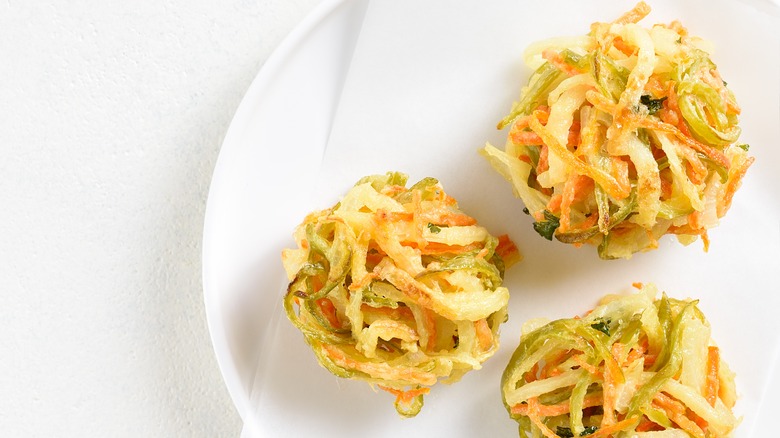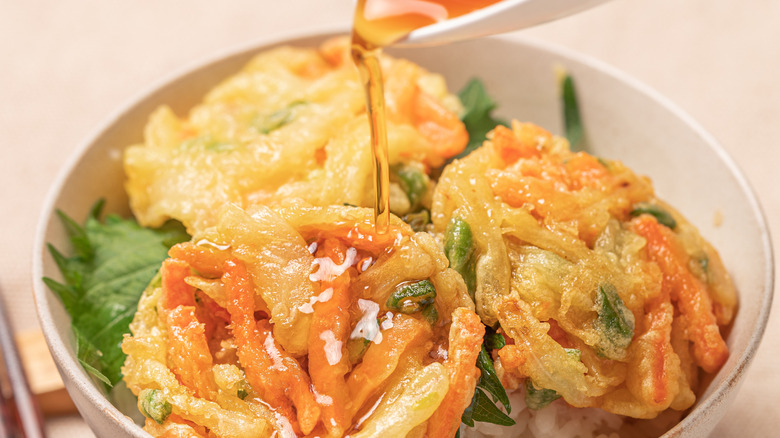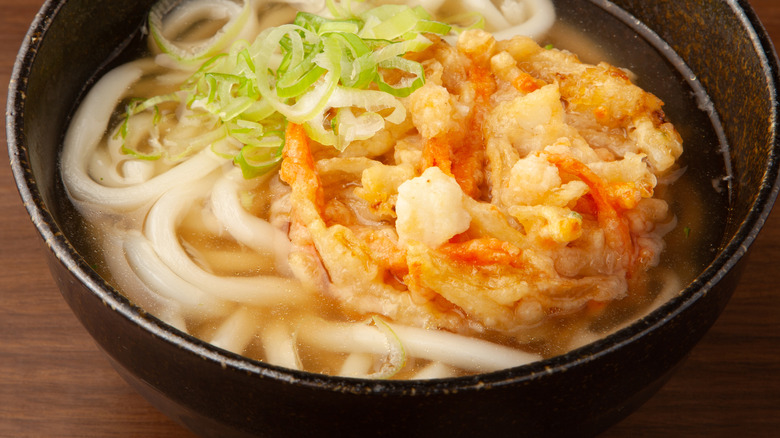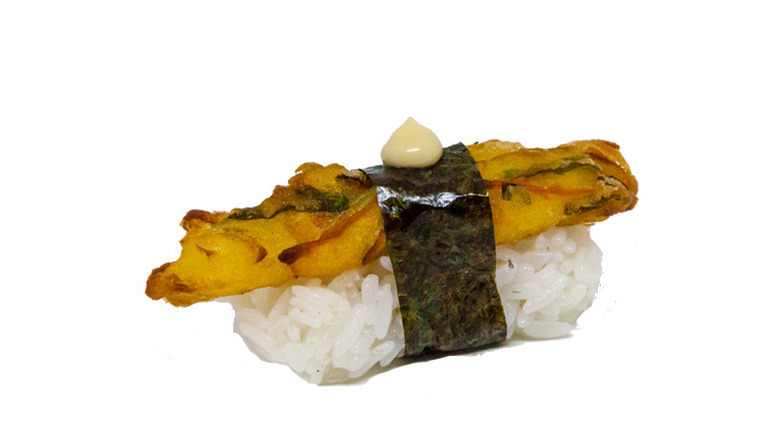3 Ways Japan's Kakiage Can Be Served
Introduced to Japan by the Portuguese in the 16th century via trade, tempura has carved out an important space among Japanese dishes (via Michelin Guide). Tempura is essentially a satisfyingly crispy dish in which its ingredients — such as seafood and vegetables — are battered in flour, egg, and water and then deep-fried, according to Sudachi Recipes.
Japanese tempuras are spectacularly diverse — each uses very specific ingredients and oils. From this wondrous variety, kakiage tempura is likely a favorite of Japanese homes because it is often made with leftovers.
There is no set of specific ingredients for kakiage, but there are a few fundamental elements like eggs and ice water for the batter, julienned carrots, shrimp or scallops, onions, and flour for the crunchy coating. To truly elevate the dish, you can use Japanese parsley (called mitsuba), sweet potatoes, mushrooms, and shrimp, per MasterClass. Then, use vegetable oil to fry your flour-coated ingredients.
This classic dish can be served in many ways — you could pack it in a bento box, serve it like fritters or pakoras with a dipping sauce or pair it with rice, noodles, or sushi.
Serve it with donburi, a rice bowl
Donburi in Japanese simply means a bowl (via Japan Guide). The term, however, has become synonymous with a rice bowl. There is a long list of donburis in Japanese cuisine, and each has its own name. A rice bowl with a pork cutlet is called katsudon and seafood rice bowls are known as kaisendon. Similarly, a rice bowl featuring kakiage is known as kakiage don, per MasterClass.
There are a few tips and tricks you could use to render the dish interesting. You can individually fry other ingredients like eggplant or shrimp to add different textural elements to the bowl, recommends Tasty. There is also a secret sauce to spruce up this instant dish. Mix soy sauce, sugar, and mirin — simmer it for a while, and then drizzle it onto your rice bowl.
Serve it atop udon and soba noodles
Thick and chewy udon noodles, made from wheat, can be immediately associated with warmth and comfort. These noodles can be served in broth or miso soup (via MasterClass) and thus, are perfect to be slurped on a cold, cozy day. In contrast, soba noodles are thinner and made from buckwheat, according to Bon Appétit. They are delicate but make for lovely additions to wholesome soups. These noodles, which let the flavors of other ingredients romance them, pair well with the homely kakiage.
The best way to eat udon noodles with kakiage is to make a soup, recommends On The Gas. The soup can be prepared from dashijiru (umami stock made from kelp, dried bonito flakes, sardines, and mushrooms), soy sauce, mirin, and sake. The boiled noodles are placed into the soup and the kakiage is placed on top. Boiled eggs or seaweed are often added as a garnish.
To make soba kakiage, it is best to use mentsuyu, water, and salt as the base, recommends Eats Japan. You can spice up this dish with a smattering of shichimi powder, which has red chili peppers, Sichuan peppercorns, dried orange peel, black sesame seeds, white sesame seeds, ground ginger, poppy seeds, and nori (via Daring Gourmet).
Nigiri and kakiage are bite-sized yum
Nigiri is easily a top-ranking sushi. It is comprised of fish placed on top of rolled sushi rice. Tuna, yellowtail, and halibut are commonly used and can be served raw or seared briefly on an open flame, says Sapporo Japanese Steakhouse. But how does this simple dish incorporate kakiage?
According to MasterClass, a small piece of the kakiage can replace the fish on top of the rice, and then it is secured with a piece of nori wrapped around it. Hanamura, a sushi restaurant in Australia, serves the crunchy treat with mayo and teriyaki sauce. You can also get your kakiage fix from retailers such as Nippon Food Supplies and JFC Australia that deliver frozen nigiri kakiage — you simply have to microwave it.
Who knew that a fritter made from leftovers could handsomely pair with both wholesome and bite-sized dishes?



